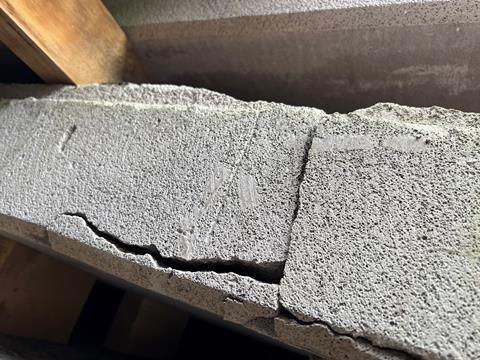Scottish Housing Regulator data reveals that a total of 16 landlords have now found RAAC in their homes.
Three more Scottish social landlords have discovered reinforced autoclaved aerated concrete (RAAC) in their homes, raising the total to 16 landlords and 2,445 homes affected by the issue.

Link Group, Linstone Housing Association, and River Clyde Homes are the latest providers to identify the lightweight concrete in their buildings.
The Scottish Housing Regulator has said that following further updates from landlords, 145 social landlords have now confirmed that there is no RAAC present in their homes.
RAAC is composed of cement, and fine aggregates like sand, calcium oxide, water, and aluminium powder, making it less dense compared to other types of concrete.
>> See also: Welsh housing association advises 40 households to leave homes due to RAAC risk
>> See also: Aberdeen City Council decides demolition is the safest option for 500 RAAC homes
It is estimated to have a lifespan of 30 years, after which it becomes more prone to crumbling and structural failure.
RAAC was predominantly used in public sector buildings constructed between the 1950s and 1990s, including schools, hospitals, police stations and social housing. It is no longer used in construction.
Bridgewater Housing Association, Irvine Housing Association, North Ayrshire Council and Perth and Kinross Council are still in the process of investigating whether RAAC is present in any of their homes.
The number of homes currently under investigation is 667.
Nicola Harcus, assistant director at the regulator, said: “We have engaged with the landlords that have identified RAAC in their homes and have assurance that they have management plans for the affected homes.”
Harcus stated that “A further four landlords are yet to fully complete their investigations into the presence of RAAC in some of their homes and we are engaging with them to get assurance about the plans they have in place to assess RAAC and timescales for completion.
“We will continue to monitor landlords’ management of RAAC through our engagement with landlords.”
In August, Aberdeen City Council approved recommendations to demolish and rebuild 504 homes that contain Reinforced Autoclaved Aerated Concrete (RAAC) in their roof panels.
The expected cost to demolish and rebuild the homes is £130m or more and will take between five and 15 years. The demolition alone is projected to cost between £20m and £25m.
In March, the Welsh housing association Trivallis instructed 40 households to leave their homes after identifying a “critical risk” related to RAAC in one of its homes.
In September 2023, the English regulator of social housing said that RAAC is not likely to be “widespread” in social housing in England, but warned registered providers to get on top of the risks posed by the material.
The sixteen landlords in Scotland that have identified the presence of RAAC in some of their homes are:
- Aberdeen City Council
- Almond Housing Association
- Angus Council
- Bield Housing & Care
- City of Edinburgh Council
- Clackmannanshire Council
- Dundee City Council
- Link Group Ltd
- Linstone Housing Association
- North Lanarkshire Council
- River Clyde Homes
- Sanctuary Scotland Housing Association
- South Lanarkshire Council
- Stirling Council
- Viewpoint Housing Association
- West Lothian Council










No comments yet